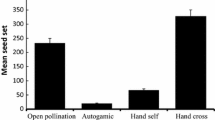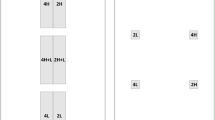Abstract
Canada mayflower (Maianthemum canadense Desf.), a rhizomatous, perennial herb, was the subject of a 2-year field experiment that examined two factors potentially affecting fruit and seed production: pollen addition and ramet isolation. Ramets were either open pollinated or overpollinated by hand to supplement natural levels. Rhizomes of the ramets were either severed, to prevent resource supplementation from the genet, or left intact. Ramets that were overpollinated matured more fruits and more seeds than ramets that were open pollinated. Thus, mayflower appears to have been pollen limited in both years. Ramets that were open pollinated and whose rhizomes were severed matured as many fruits, seeds, and seeds/fruit as ramets that were open pollinated and whose rhizomes were left intact. Ramets that were overpollinated and whose rhizomes were severed matured fewer fruits, seeds, and seeds/fruit than overpollinated ramets whose rhizomes were left intact. It appears that at natural levels of pollination, mayflower ramets are physiologically independent but as the level of pollen increases, mayflower ramets receive support from other parts of the genet.
Similar content being viewed by others
Author information
Authors and Affiliations
Additional information
Received: 13 May 1996 / Accepted: 1 November 1996
Rights and permissions
About this article
Cite this article
Ganger, M. The influence of pollen addition and ramet isolation on current sexual reproduction in a clonal herb. Oecologia 110, 231–236 (1997). https://doi.org/10.1007/s004420050155
Issue Date:
DOI: https://doi.org/10.1007/s004420050155




